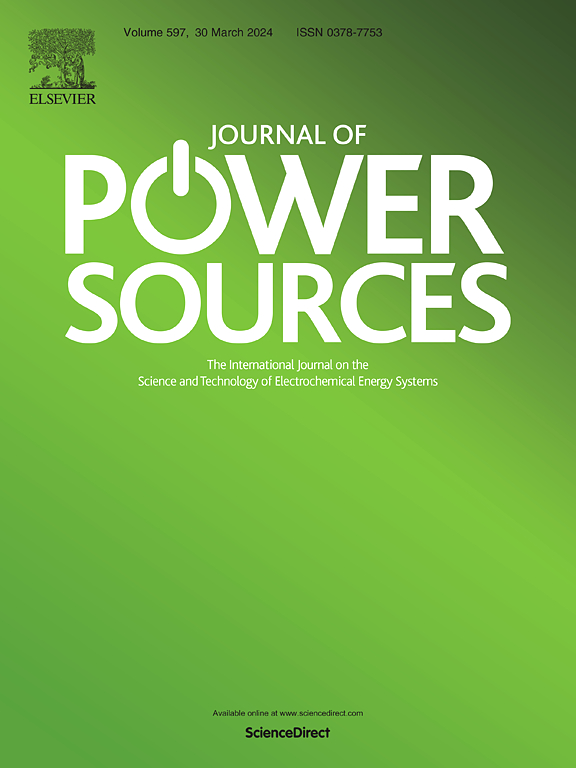用于提高硅石墨/NMC(Ni = 80-83%)高能锂离子电池的循环寿命和安全性的碳酸乙烯酯/碳酸丙烯酯电解质
IF 8.1
2区 工程技术
Q1 CHEMISTRY, PHYSICAL
引用次数: 0
摘要
高能硅碳(Si-C)电极与 "高镍 "NMC 阴极配对,用于优化 "不含线性烷基碳酸盐 "的电解液。优化工作通过在纽扣电池中使用两组硅碳复合电极对 23 种电解液配方进行筛选。然后,使用单层袋式电池和商用表面活性剂涂层隔膜,在更接近其最终应用的环境中 "验证 "了最佳电解质配方,以解决该系列电解质在传统和陶瓷涂层隔膜中遇到的润湿问题。尽管这种电解液在 1C 以上的速率能力较低,但在使用 9% 碳化硅阳极和 NMC83 阴极的袋式电池中,其容量保持率提高了 45%。电解液的安全性也显著提高。在高达 4.3V 和 5.0V 的循环过程中,不含线性碳酸盐的电解液在 3 个循环中的氢气挥发总量减少了 3.6 倍以上。此外,加速度热量测定法显示,使用这些电解质可提高该电解质的整体电池安全性,这表明,对于高能量应用而言,采用适当添加剂组合的 EC/PC 电解质可延长循环寿命并提高安全性。本文章由计算机程序翻译,如有差异,请以英文原文为准。
An ethylene carbonate/propylene carbonate electrolyte for improved cycle life and safety of silicon-graphite/NMC (Ni = 80–83 %) high-energy lithium-ion battery cells
High energy Silicon-Carbon (Si-C) electrodes have been paired with ‘high Nickel’ NMC cathodes and used to optimize a ‘linear alkyl carbonate-free’ electrolyte. The optimization was conducted via the screening of 23 electrolyte formulations using two sets of silicone carbon composite electrodes in coin cells. The best electrolyte formulation was then ‘validated’ in a setting closer to their final application, using single layer pouch cells and a commercial surfactant coated separator to solve the wetting issue met with this family of electrolytes with both conventional and ceramic coated separators. Despite its lower rate capability above 1C, this electrolyte allows a 45 % increase of the capacity retention in pouch cell with a 9 % Si-C-based anode and a NMC83 cathode. The safety of the electrolyte is also improved markedly. During cycling up to 4.3V and 5.0V, the total volume of hydrogen evolved was reduced more than 3.6 times over 3 cycles for the electrolyte free of linear carbonates. In fine, accelerating rate calorimetry shows that the use of these electrolytes improves the overall cell safety for this electrolyte, which shows that, for high energy applications, EC/PC electrolytes with the right additive combination can allow both longer cycle life and improved safety.
求助全文
通过发布文献求助,成功后即可免费获取论文全文。
去求助
来源期刊

Journal of Power Sources
工程技术-电化学
CiteScore
16.40
自引率
6.50%
发文量
1249
审稿时长
36 days
期刊介绍:
The Journal of Power Sources is a publication catering to researchers and technologists interested in various aspects of the science, technology, and applications of electrochemical power sources. It covers original research and reviews on primary and secondary batteries, fuel cells, supercapacitors, and photo-electrochemical cells.
Topics considered include the research, development and applications of nanomaterials and novel componentry for these devices. Examples of applications of these electrochemical power sources include:
• Portable electronics
• Electric and Hybrid Electric Vehicles
• Uninterruptible Power Supply (UPS) systems
• Storage of renewable energy
• Satellites and deep space probes
• Boats and ships, drones and aircrafts
• Wearable energy storage systems
 求助内容:
求助内容: 应助结果提醒方式:
应助结果提醒方式:


